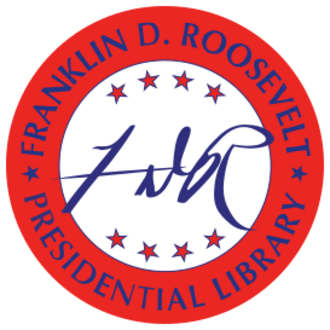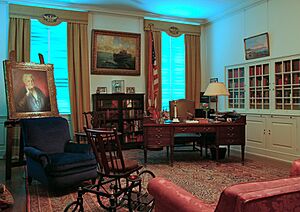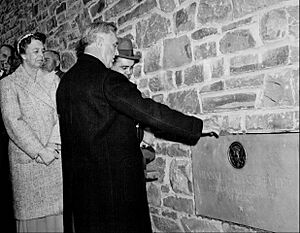Franklin D. Roosevelt Presidential Library and Museum facts for kids
Quick facts for kids Franklin D. Roosevelt Presidential Library |
|
|---|---|
 |
|

Entrance To Franklin D. Roosevelt National Historic Site
|
|
| General information | |
| Location | Hyde Park, New York, United States |
| Coordinates | 41°46′07″N 73°56′03″W / 41.768680°N 73.934115°W |
| Named for | Franklin Delano Roosevelt |
| Construction started | 1939 |
| Completed | 1940 |
| Inaugurated | Dedicated on 30 June 1941 |
| Cost | $376,000 |
| Management | National Archives and Records Administration |
| Technical details | |
| Size | 16 acres (6.5 ha) |
The Franklin D. Roosevelt Presidential Library and Museum is a special place in Hyde Park, New York. It's called a presidential library because it keeps all the important papers and items from Franklin D. Roosevelt's time as president. He was the 32nd president of the United States from 1933 to 1945.
This library is located on the grounds of Springwood, which was the Roosevelt family's home. President Roosevelt himself helped plan and build the library between 1939 and 1940. It officially opened on June 30, 1941. This was the very first presidential library in the United States! Today, it's one of thirteen such libraries managed by the National Archives and Records Administration.
Contents
Why This Library Was Built
Franklin D. Roosevelt loved collecting things and learning about history. As president, he led the country through a very tough time called the Great Depression. He knew he had collected a huge amount of historical papers, books, and other items during his life. He wanted a special place to keep them all safe and organized. This way, people could learn from them in the future.
The library was built by a company from Philadelphia called John McShain. President Roosevelt and his mother, Sara Delano Roosevelt, donated 16 acres of their land for the building. Margaret Suckley, who helped Roosevelt with his personal records, also played a big part in setting up the library. She even worked there as an archivist for the first twenty years.
A New Way to Keep Presidential Papers
Before President Roosevelt, there was no clear plan for what happened to a president's papers after they left office. These papers were considered private property. Presidents could take them home, sell them, or even destroy them. This meant that important parts of American history could be lost or hidden from scholars for a long time. Some papers eventually ended up in places like the Library of Congress or private collections.
Franklin D. Roosevelt changed this. He was the first president to give all his papers to the government. This made them available for everyone to see and study. His collection included records from all his public jobs:
- New York state senator (1911–1913)
- Assistant secretary of the Navy (1913–1920)
- Governor of New York (1929–1932)
- President of the United States (1933–1945)
He also included his personal collections, like books and items about the U.S. Navy and Dutchess County, New York.
Where the Library Is and What It Looks Like
The library is located on the grounds of the Roosevelt family's Hyde Park estate. It's built from local Hudson Valley fieldstone. Its style reminds people of the old Dutch colonial buildings that Roosevelt liked. President Roosevelt even drew a sketch in 1937 showing where he wanted the building to be and what its basic shape would be.
The main architect, Louis A. Simon, and a consulting architect, Henry J. Toombs, used Roosevelt's sketches to design the building. The library was built using money donated by private citizens, costing $376,000. It was given to the federal government on July 4, 1940, to be run by the National Archives.
Robert D.W. Connor, the first Archivist of the United States, said that President Roosevelt making his papers public was "the nation's answer to the historian's prayer." This means it was a dream come true for people who study history.
When the library was finished in 1940, it was already getting full! Roosevelt didn't expect to be president for more than two terms. By 1950, the library held about 50 million items. This included 16,000 books, 15,000 photographs, 275,000 feet of movie film, and 300 sound recordings.
In the 21st century, the library had a big renovation, its first ever. It reopened on June 30, 2013. This multi-million dollar project was paid for by public and private donations. It added more space for exhibits, updated the heating and cooling systems, and improved the research rooms. Members of the Roosevelt family and historian Geoffrey C. Ward spoke at the reopening ceremony.
Other Important Collections
When the library was first planned, President Roosevelt hoped that his wife, Eleanor Roosevelt's, papers would also be kept there. In 1942, he even drew a rough sketch for new sections to be added to the building if more space was needed for her papers. When Mrs. Roosevelt passed away in 1962, her papers filled three million pages!
During her time working at the library (1961–1969), Elizabeth B. Drewry helped raise money for these new sections. They were built in 1972. The library also holds papers donated by other people connected to Roosevelt, like Henry Morgenthau Jr.'s diary, which has 840 volumes.
The Presidential Libraries Act
Because of what Roosevelt did, Congress passed the Presidential Libraries Act in 1955. This law created a clear process for how future presidents' papers would be kept. It said that libraries would be built with private money but maintained by the federal government. Now, every president from Herbert Hoover to George W. Bush has a presidential center overseen by the National Archives.
Later, in 1978, the Presidential Records Act made official presidential papers public property. This law also set limits on the size and cost of presidential museums.
The Museum Section
President Roosevelt hoped the library would be an important place for research and that many people would visit the museum. The museum part of the building opened on June 30, 1941. However, World War II started, which changed Roosevelt's plans. The official opening of the library as a research center was delayed because he served a third term and then was elected for a fourth term in 1944.
During the war, he often visited the library to sort and organize his records and items. From his study in the library, he gave several of his famous wartime radio speeches, known as "fireside chats." These were informal talks where he spoke directly to the American people.
President Roosevelt made his last visit to Hyde Park in March 1945. He passed away on April 12, 1945, in Warm Springs, Georgia, at the age of sixty-three.
See also
 In Spanish: Biblioteca y Museo Presidencial de Franklin D. Roosevelt para niños
In Spanish: Biblioteca y Museo Presidencial de Franklin D. Roosevelt para niños




